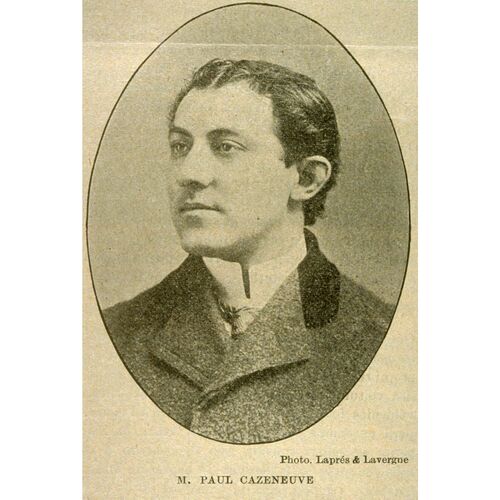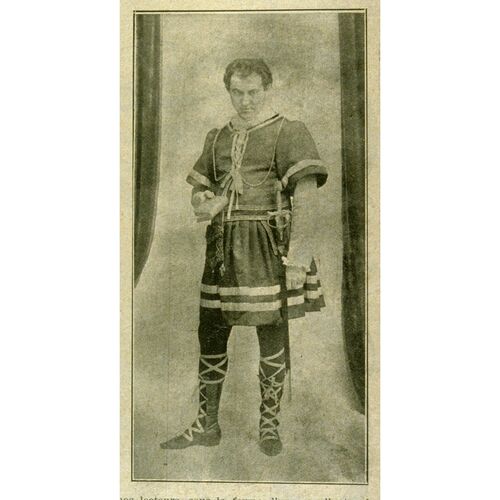ALBA, GEORGES, known as Paul Cazeneuve (Cazenuve) (at birth he was given the names Georges-Jean-François-Paul-Charles-Ludovic), actor and theatre director; b. 11 May 1871 in Revel, France, son of Gabriel Alba, a teacher, and Augusta Grillières; m. first 27 June 1894 Eleonore M. E. Balch in Boston, and they had one son and one daughter; m. secondly 17 Nov. 1920 Orpha L. Kinne, widow of Edgar L. Taylor, in Los Angeles; they had no children; d. 22 June 1925 in Hollywood (Los Angeles).
Georges Alba was said to be the godson of Joseph-Amédée-Victor Capoul, a famous French tenor who toured Quebec in 1883. He reportedly made his debut as an actor at the age of four and a half in Toulouse, France, his godfather’s hometown. Since his father moved to the United States to teach at Harvard University in Cambridge, Mass., in all probability as a professor of law, Paul Cazeneuve, as he would be called from then on, made his real debut in the United States in 1889 with a French troupe, the Maude Banks, which he accompanied to Montreal that year. He would be a member of the company for two years. At the same time, he was studying with Tomasso and Alessandro Salvini and the Shakespearean actor John A. Lane. During the 1891–92 season he accompanied actress Hortense Barbe-Loret, known as Mme Rhéa, on her tours. He shared the stage with the greatest celebrities of the day, including Edwin Thomas Booth and Helena Modjeska. In 1893 he returned to Montreal.
From 1896 to 1898 Cazeneuve performed in Canada and the United States at the head of his own company. In February 1899 he was in Montreal and Quebec with the Columbia Stock Company. His roles included Mephisto in an adaptation of Goethe’s Faust and the Italian in Melbourne. The Montreal Gazette pointed out that although the young actor performed in English, he attracted to the theatre a large part of the French-speaking public which had already adopted him.
On 18 Feb. 1901 Cazeneuve again staged Melbourne at Her Majesty’s Theatre in Montreal. At the same time, he was hired as an actor and artistic director by George Gauvreau, who wanted to raise his Théâtre National Français, built the previous year, to the standards of the English-language theatres. Cazeneuve opened on 11 March with his own French adaptation of Faust, based on Lewis Morrison’s version. His stage setting immediately won over both the public and the critics, who praised the magnificence of the sets and costumes and the daring use of electrical effects. The play ran for 28 consecutive performances and drew an audience of more than 12,000 in a single week. Cazeneuve continued to favour large-scale productions in the American style, and in June 1901 he added the future film-maker Léo-Ernest Ouimet* to his company as lighting engineer. Ouimet developed new systems to mount a stunning production of Quo Vadis? by Henryk Sienkiewicz. Cazeneuve built his repertoire from foreign playwrights, often selecting French plays adapted into English, which he then translated back into French! He promoted local works, however, in particular those of Louis Guyon*. He would produce four of Guyon’s plays: Denis le Patriote (1902), Joe Montferrand (1903), Un mariage à la gaumine (1904), and Montcalm (1907). In October 1903 La Patrie described Joe Montferrand as “a magnificent portrait of Canadian customs.” In September 1904 Cazeneuve left the Théâtre National Français to organize a season at the Auditorium de Québec. He left the city in March 1905, having presented much the same repertoire as in Montreal. At the same time, he made several tours to a number of smaller centres, including Sorel and Trois-Rivières. On his return to Montreal, he undertook a summer season at the Théâtre Français, from 29 May to 8 July, during which he produced the Montreal premiere of Un fil à la patte by Georges Feydeau, but the endeavour was not a great success.
In 1906 Cazeneuve returned to the Théâtre National Français as artistic director and co-owner of the establishment, which had undergone a relative decline since his departure. He rightly attributed this situation to too much repetition of the same repertoire and the overly cautious approach of his successors. His stroke of genius during his second term as director was to bring variety shows back into style with Ohé! Ohé! Françoise! by Ernest Tremblay, Léon May, and Gaston Dumestre; in January 1909 the show drew 40,000 spectators in three weeks, establishing in the Quebec public a taste for political revues. The Françoise of the title was none other than Robertine Barry*, a journalist and the editor of Le Journal de Françoise (Montreal). The revue was intended as an allegory of the problems facing Montreal at that time, when the municipal administration was being increasingly disparaged. It took on standards of political morality by putting the municipal council on stage, and attacked public utilities such as the tramways and electricity monopolies, and the problem created by the presence of both streetcars and automobiles on the streets. It was a sarcastic portrayal of a city on the verge of being put under trusteeship [see Lawrence John Cannon]. The revue was a success because it hit home: the townspeople recognized themselves in it.
Later that year Cazeneuve again left the Théâtre National Français, but he would no longer enjoy the same success in his career. The growing popularity of the cinema was slowing the advance of theatre in Montreal. He tried his luck in other francophone theatres in the city and even renewed his association with the English-language stage by taking on, among other things, a season at the New Empire Theatre for a few weeks in 1917–18. Since the situation had not improved, he left Montreal for Hollywood around 1919 to begin a new career in motion pictures. Cazeneuve got a few small roles in silent films such as The Queen of Sheba (1921) and The French doll (1923). In 1923 he and Ouimet, who had been living in Los Angeles since 1921, made Why get married?, which proved a failure. Cazeneuve also suggested scenarios for Faust and for Maria Chapdelaine, by Louis Hémon*, but these plans did not materialize. A serious illness that would eventually prove fatal forced him to give up the cinema. At the beginning of 1925 he went to Montreal for treatment at the Royal Victoria Hospital. He then returned to Hollywood but suffered a relapse from which he did not recover. He was so destitute when he died that actor William Farnum had to pay the expenses of his illness and funeral.
Paul Cazeneuve had had an impressive career, producing 300 French, English, and American plays and acting in some 200 roles. His use of American theatrical techniques would revitalize the Quebec stage to such a degree that he is considered one of the founders of French-language theatre in Montreal. Some critics would accuse him of sacrificing dramatic content for the sake of effect, of sometimes changing the structure of plays by blithely abbreviating them, and of ignoring an authentic French repertoire. However, he succeeded thereby in attracting to French theatre a public that had previously been too strongly influenced by the sensationalism of American companies. At a time when Quebec still had no theatre school, Cazeneuve made professionals of amateurs such as Elzéar Hamel, Joseph-Philéas Filion*, Antoine Bailly (known as Antoine Godeau), and Joseph-Sergius Archambault (known as Palmieri). As a person, Cazeneuve was remembered by anglophone and francophone audiences alike for his charm and old-world courtesy. His passing marked the end of the old guard that had transformed the theatre in Montreal and Quebec at the beginning of the 20th century.
Arch. Départementales, Haute-Garonne (Toulouse, France), État civil, Revel, 11 mai 1871. Bibliothèque Nationale du Québec (Montréal), Div. des coll. spéciales, Programmes de théâtre, 9.19 (Théâtre national français), semaine du 11 mars 1901. Gazette (Montreal), 7 Feb. 1899, 16 Feb. 1901. Le Monde illustré (Montréal), 30 mars 1901. Montreal Daily Star, 27 June 1925. Le Passe-Temps (Montréal), 1er juin 1907. La Patrie, 9 janv. 1909, 25 juin 1925. La Presse, 27 févr., 9 mars 1901; 27 mai, 1er juill. 1905; 12 janv. 1909; 6 août 1910; 25 juin 1925. Quebec Daily Mercury, 3 Feb. 1899. Le Soleil, 14 sept. 1904. Christian Beaucage, Le théâtre à Québec au début du XXe siècle: une époque flamboyante! ([Québec], 1996), 30–34, 70–73, 75–77. L.-H. Bélanger, Les Ouimetoscopes: Léo-Ernest Ouimet et les débuts du cinéma québécois (Montréal-Nord, 1978), 206–14. Jean Béraud, 350 ans de théâtre au Canada français (Ottawa, 1958), 96. Brooks Bushnell, Directors and their films: a comprehensive reference, 1895–1990 (Jefferson, N.C., 1993), 98, 203. Denis Carrier, “Le premier directeur artistique du National: Paul Cazeneuve,” L’Annuaire théâtral (Montréal), automne 1987: 153–64. Franklin Graham, Histrionic Montreal; annals of the Montreal stage . . . (2nd ed., Montreal, 1902; repr. New York and London, 1969). Renée Legris et al., Le théâtre au Québec, 1825–1980: repères et perspectives (Montréal, 1988), 53–58. Magill’s survey of cinema – silent films, ed. F. N. Magill et al. (3v., Englewood Cliffs, N.J., 1982), 3: 892–95. David Ragan, Who’s who in Hollywood, 1900–1976 (New Rochelle, N.Y., 1976), 572. G.-É. Rinfret, Le théâtre canadien d’expression française: répertoire analytique des origines à nos jours (4v., [Montréal], 1975–78), 3: 176–79.
Revisions based on:
Ancestry.com, “U.S., social security applications and claims index, 1936–2007”: www.ancestry.ca (consulted 8 Nov. 2017). Church of Jesus Christ of Latter-day Saints, “California, county marriages, 1850–1952”; “California death index, 1905–1939”; “Massachusetts, town clerk, vital and town records, 1626–2001”; “New York, New York City births, 1846–1909”: www.familysearch.org (consulted 8 Nov. 2017). Minn. Assoc. of County Officers, “Minnesota official marriage system”: www.moms.mn.gov (consulted 26 March 2018).
Cite This Article
Mireille Barrière, “ALBA, GEORGES, known as Paul Cazeneuve (Cazenuve) (Georges-Jean-François-Paul-Charles-Ludovic),” in Dictionary of Canadian Biography, vol. 15, University of Toronto/Université Laval, 2003–, accessed December 5, 2025, https://www.biographi.ca/en/bio/alba_georges_15E.html.
The citation above shows the format for footnotes and endnotes according to the Chicago manual of style (16th edition). Information to be used in other citation formats:
| Permalink: | https://www.biographi.ca/en/bio/alba_georges_15E.html |
| Author of Article: | Mireille Barrière |
| Title of Article: | ALBA, GEORGES, known as Paul Cazeneuve (Cazenuve) (Georges-Jean-François-Paul-Charles-Ludovic) |
| Publication Name: | Dictionary of Canadian Biography, vol. 15 |
| Publisher: | University of Toronto/Université Laval |
| Year of publication: | 2004 |
| Year of revision: | 2020 |
| Access Date: | December 5, 2025 |


![M. Paul Cazeneuve [image fixe] / A.J. Rice, Laprés & Lavergne Original title: M. Paul Cazeneuve [image fixe] / A.J. Rice, Laprés & Lavergne](/bioimages/w600.3350.jpg)


